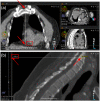Relative thoracic changes from supine to upright patient position: A proton collaborative group study
- PMID: 37633842
- PMCID: PMC10691637
- DOI: 10.1002/acm2.14129
Relative thoracic changes from supine to upright patient position: A proton collaborative group study
Abstract
This study presents position changes of a few radiotherapy-relevant thoracic organs between upright and typical supine patient orientations. Using tools in a commercial treatment planning system (TPS), key anatomical distances were measured for four-dimensional CT data sets and analyzed for the two patient orientations. The uncertainty was calculated as the 95% confidence interval (CI) on the relative difference for each of the four analyzed changes for upright relative to supine, as follows: the distance of the bottom of the heart to the top of the sternum, it changed +2.6% or +4 mm (95% CI [+0.30%,+4.9%]); the distance of the center of the C3 vertebra to the backrest, it changed +29% (95% CI [+22%,+36%]); the contoured left and right lungs increased their volumes respectively: +17% (95% CI [+12%,+21%]) for the left, and +9.9% (95% CI [+4.1%,+16%]); and lastly, the distance from the top of the sternum to the top of the liver, but its uncertainty far exceeded the average change by a factor of two. This last result is therefore inconclusive, the others show that with 95% confidence that a change in internal positions is observed for lung volumes and heart position that could be important for upright treatments.
Keywords: patient positioning; proton therapy; seated treatment.
© 2023 The Authors. Journal of Applied Clinical Medical Physics published by Wiley Periodicals, LLC on behalf of The American Association of Physicists in Medicine.
Conflict of interest statement
This study was partially funded by Leo Cancer Care
Figures




References
-
- Rahim S, Korte J, Hardcastle N, Hegarty S, Kron T, Everitt S. Upright radiation therapy—a historical reflection and opportunities for future applications. Front Oncol. 2020;10:213. Frontiers, Frontiers, 1 Jan. 1AD. www.frontiersin.org/articles/10.3389/fonc.2020.00213/full - DOI - PMC - PubMed
-
- Mackie TR, Towe S, Schreuder N. Is upright radiotherapy medically and financially better? AIP Conf Proc. 2021;2348:020002. doi:10.1063/5.0051770 - DOI
-
- Jinzaki M, Yamada Y, Nagura T, et al. Development of upright computed tomography with area detector for whole‐body scans: phantom study, efficacy on workflow, effect of gravity on human body, and potential clinical impact. Invest Radiol. 2020;55(2):73‐83. doi:10.1097/RLI.0000000000000603 - DOI - PMC - PubMed
-
- Yang J, Chu D, Dong L, Court LE. Advantages of simulating thoracic cancer patients in an upright position. Pract Radiat Oncol. 2014;4:e53‐e58. 2. - PubMed
-
- Reiff JE, Warner‐Wasik M, Valicenti RK, et al. Changes in the size and location of kidneys from the supine to standing positions and the implications for block placement during total body irradiation. Int J Radiat Oncol Biol Phys. 1999;45:447‐449. - PubMed
MeSH terms
Substances
LinkOut - more resources
Full Text Sources
Miscellaneous

